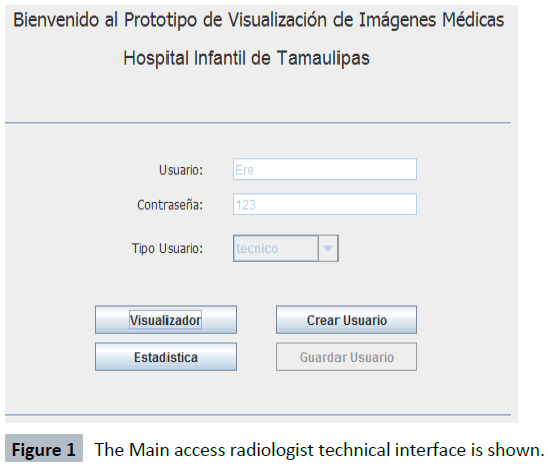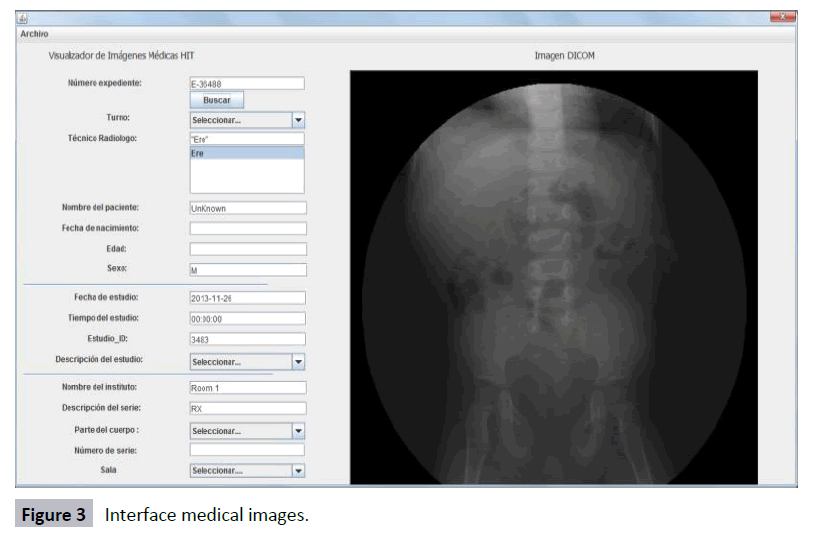Alternative Digital Scheme Java-based for a ChildrenÃÆâÃâââ¬Ãâââ¢s Hospital Radiology Department
Linares FM
DOI10.4172/2471-9781.100030
Department of Bioengineering, Autonomous University of Baja California, USA, Mexico
- *Corresponding Author:
- Francisco Mesa Linares , PhD
Full time Professor Researcher
Department of Bioengineering
Autonomous University of Baja California
USA, Blvd Universitario #1000 Tijuana BC C.P. 21500, USA, Mexico
Tel: (+52) 664-285-1174
E-mail: fmesa@uabc.edu.mx
Received date: June 15, 2017; Accepted date: June 25, 2017; Published date: June 30, 2017
Citation: Linares FM (2017) Alternative Digital Scheme Java-based for a Children’s Hospital Radiology Department. J Hosp Med Manage. Vol. 3 No. 1:10
Abstract
Digital medical images are an indispensable element for clinical diagnosing. The facility of handling information generated through them, allow obtaining statistical data associated to several health indicators. Standards such as DICOM and PACS software are designed for manipulating medical images and information. However, its use in some cases require expensive licenses, or computer knowledge that medical personnel area is not necessarily called to possess. Sometimes even, the needs of a hospital are much lower that the registered on such software. This article proposes the design of informatics software based on Open Source technology. The prototype has three desktop interfaces easily accessible for handling basic information. It will allow the extraction of information from medical images generated in DICOM format. The software also allows the recording and processing of statistical calculations that are necessary for the development of scientific and administrative reports at the radio diagnostic department. The prototype developed, is of simple handling, reduced cost of licensing, and can be implemented in both, conventional computer and mobile devices. Software allows visualizing image and data from other departments at clinical. The implementation of the prototype test was developed at radiological department of the Children's Hospital of Tamaulipas, México
Keywords
Medical imaging; PACS, DICOM; Open source; Children’s hospital
Introduction
The Picture Archiving and Communication System (PACS), allow to store and transmit medical images, constituting a vital instrument in the areas of radio diagnostic, radiotherapy and interventional radiology [1,2]. The PACS concept listed since 1982 during the first International Workshop and Conference on PACS for Medical Applications [3], and includes different modes of image sources, displays, communication networks and digital files for data storage and retrieval. The PACS systems work based on the Digital Imaging and Communication in Medicine (DICOM) protocol, which has different services associated to storage of images, search / retrieval, worklists and printing [4,5].
Among the main needs that often occur related to work in a radio diagnostic department, correspond to share medical images to other departments across the network. This requires a significant investment, as each service with which account DICOM represent a license and each license is an additional cost within the PACS [6,7]. However, since technology and licenses related to PACS development is expensive, it is sometimes difficult for some clinical centers to obtain necessary financial resources for your acquisition [8]. Fortunately there are other technologies that have provided an alternative solution to the high cost of these licenses through Open Source applications.
Report of George et al. [9] perform an important about the evaluation of virtual machines with hardware and software resources of Open Source installation on PACS. Another solution found for the alternative PACS uses is using Mini-WebPacs, which is based on a Web standard architecture using Open Source [10], which were designed to work with hardware platforms inexpensive. The MiniWebPacs can be classified as Mini Pacs and implemented in Java using Open Source libraries dcm4che [11,12].
The design of a prototype open-source-based is presented. The software has been designed for sharing medical images between departments and mobile devices through local network. The proposal has been conceived under essentially altruistic scheme, and focused on the assessment of needs and potentials associated with the equipment with which account radiology unit at Children's Hospital of Tamaulipas, México.
Material and Methods
The report is focuses on the development of a prototype which allows sharing medical images archived in DICOM format. The technological tools for the prototype design were developed through the Java programming language. A dcm4che tool Kit for developing open in designing PACS code was used. Wampserver network server and MySQL database were used for prototype development. Some tables for storage of the tool from DCM4CHE were used. Eclipse tool was used for the development of interfaces for mobile devices.
Results and Discussions
The prototype has been designed for three types of users: radiologist, physician and administrative personnel (receptionist). Interfaces were developed based on the roles or activities on service users inside the radiology department at Children's Hospital of Tamaulipas. The prototype starts with sign in of user name, password and user type selection Figure 1. Only user type option is activated. The three prototype interfaces are described below.
Interface radiologist
In addition to operating imaging equipment, X-ray technicians are responsible for special studies, and entering patient data (file number/folio, patient´s name, year of birth, age, sex, comments patient, examined body part and description of special study to be performed) in the Toshiba computer system. Once the technical capture patient data, it should be x-rayed, whose image stored in the database system. Completed this procedure, the technician proceeds to copy the information to a USB flash drive, and inserts information in the prototype. The technical interface allows access to statistical data; create user and visualizations (display). In last one, the technician can add medical images through the File menu Figure 2, and upload patient's folder. On this way, clinical personnel can display images in different interfaces of the prototype.
Interface physician
Physician inserts the file or patient folio number and images charged to the prototype Figure 3 are displayed. Patient data are extracted from image in DICOM format. This user can only display the images, without making changes to it.
Interface of administrative personnel
The third user interface refers to the person responsible for register of patient files register, as well as for to obtain and processing statistical data that are required for administrative reports.
Conclusions
The design of a software prototype based on Open Source technology for medical imaging is presented. The prototype consists of three desktop interfaces easily accessible, allowing the manipulation of basic information associated with the clinical record. It has been designed to allow extraction of information from medical images generated in DICOM format, and even other types of studies conducted in the hospital.
With access to the prototype, hospital administrative staff may obtain and generate statistical data. Their implementation within a radiology unit, it will allow other departments at the hospital can displays images supporting doctors to have information more timely. It will also allow the reduction of costs in terms of chemical material on developing medical imaging, as well as reducing developed films.
The prototype has been designed to improve the process used for to make a special study and to take a simple radiography in the health center of reference. With the implementation of the prototype, physicians will be supported to display the information in the required time, either through the PC or through a mobile device. This will aid to prevent and optimize the access time to medical images, easing of administrative management.
The prototype developed is simple to use, reduces licensing costs and implemented on conventional computing equipment, considering its potential implementation even on mobile devices. The case study to test the operation of the prototype was developed at the Children's Hospital of Tamaulipas.
Acknowledgements
The authors wish to express appreciation to the Children's Hospital of Tamaulipas, for total support to carry out this study. In addition, we express our gratitude to the Autonomous University of Santo Domingo, Dominican Republic, for financial help to travel and international collaboration.
References
- Gaytos B (2001) Developing policies and procedures for a picture archiving and communication system. J Digit Imaging 14: 44-47
- Arora D, Mehta Y (2014) Use of picture archiving and communication system for imaging of radiological films in cardiac surgical intensive care unit. J Anaesthesiol Clin Pharmacol 30: 447-448
- Beir L (1999) The importance of a picture archiving and communications system (PACS) manager for large-scale PACS installations. J Digital Imaging 12: 37-37
- Bidgood W, Steven C Horii, Fred W Prior, Donald E, Syckleet V (1997) Understanding and Using DICOM, the Data Interchange Standard for Biomedical Imaging. J Am Med Inform Assoc 4: 199-212
- Behlen F (1998) A DICOM document-oriented approach to PACS infrastructure. J Digit Imaging 11: 35-38
- Becker S, Arenson R (1994) Costs and benefits of picture archiving and communication systems. J Am Med Inform Assoc 1: 361-371
- Reiner B, Siegel E (2000) Understanding financing options for PACS implementation. J Digit Imaging; 13: 49-54
- Cao P (2003) An integrated medical image database and retrieval system using a web application server. Inter J Med Infor 71: 51-5
- George C, Alexakos C, Steve G Langer, French T (2012) Using an Open Source PACS Virtual Machine for a Digital Angiography Unit: Methods and Initial Impressions. J Digit Imaging 25: 81-90
- Moreno R, Thomas PN Iversen, Nielsen KS, Furuie SS, Gutierreza MA, et al. (2005) MiniWEBPACS-A Compact System for Storage and Retrieval of Medical Images. Comput Methods Programs Biomed 20: 1
- Takizawa M, Sone S, Imai S, Sakai F, Imai Y, et al. (1991) Practical mini-PACS based on a hybrid video and digital network. Comput Methods Programs Biomed 36: 119-124
- Azevedo-Marques P (2011) Implantação de um mini-pacs em hospital universitário.Radiol Bras 34: 221-224
Open Access Journals
- Aquaculture & Veterinary Science
- Chemistry & Chemical Sciences
- Clinical Sciences
- Engineering
- General Science
- Genetics & Molecular Biology
- Health Care & Nursing
- Immunology & Microbiology
- Materials Science
- Mathematics & Physics
- Medical Sciences
- Neurology & Psychiatry
- Oncology & Cancer Science
- Pharmaceutical Sciences



